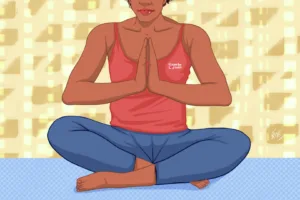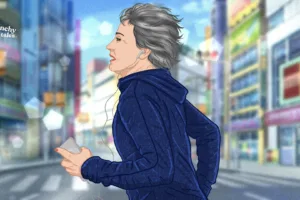Five Tibetans: The Ancient Secret Of The Source Of Youth
Menopause can sap your energy, but you can re-invigorate yourself on a daily basis with a simple and yet effective ritual practised by Buddhist monks for more than 2500 years. The Five Tibetans, also known as the “Fountain of Youth“, are a series of five yoga-type exercises meant to be repeated 21 times in a row, once a day, to increase the body’s energy and restore balance from head to toe.
Fighting menopause symptoms
Since the Tibetan rites – introduced to the Western Culture in the 20th century, by author Peter Kelder – stimulate the endocrine organs, they are believed to be particularly efficient in fighting hormonal imbalance and menopausal symptoms such as fatigue, brain fog, memory loss and overall stiffness. Some testimonials included in Peter Kelder’s book The Ancient Secret of The Fountain of Youth also refer their grey hair turning back to the original colour and their eye-sight getting better again, while others noticed to have lost weight and found relief to aches caused by arthritis as well as sciatic pains and headaches.
The Five Rites are very beneficial for middle-aged women as we get to work on our balance, flexibility and strength in a short sequence of only 5 simple exercises – says Adriana Potts, yoga instructor and founder of Adri Flow and Fitness. -They’re a brilliant way of getting some exercise into your day in only about 15 minutes. And since the same exercises are repeated day after day, they become so automatic, you don’t have to think too much. However, you can notice and be proud of your progress as you are able to refine the movements and increase the repetitions.
It would be preferable to do them in the morning, before having breakfast, when we first get up from the bed. Beginners can perform the movements 3-5 times each, and then increase the repetitions by two each week, finally arriving at the perfect number, 21.
A daily practice to achieve youth and vigour
The idea behind the Tibetan Rites is to stimulate the seven energy vortexes – chakras in Hindu – in our body. Experienced practitioners claim that youth and vigour can be achieved when these vortexes spin at the same rate, thanks to the daily practice of the Rites. Your body will slowly become stronger, more coordinated and flexible, while your mind learns to focus better and relax fully.
The seven chakras are connected to the body’s real endocrine organs – explains Zackary Davis in his book The Five Tibetan Rites: How To Stimulate Your Chakras-. Late medical exploration has revealed persuading evidence that the ageing process is hormone-directed. The five Tibetans are said to standardize hormonal lopsided imbalances in the body, thus leading the way to longer youth, wellbeing and energy. Performing the rites daily can also help reduce lower back pain, relieve joint pain and stiffness, and improve blood circulation.
Since the exercises work on the abdomen, sides, back, legs, arms and shoulders, your posture naturally improves as well. As for the mind, concentrating on your breathing will improve the quality of sleep, reduce anxiety and improve energy levels, resulting in a more youthful overall appearance.
I practise the Five Tibetan Rites regularly since a few years and have noticed both mental and physical improvements: my memory has gotten better and the quality of sleep has increased – states Miriam Gualtieri, 47, a practitioner of the Rites from Italy-. Physically I feel stronger and more energized.
How to practice the Five Rites
The first rite aims at stimulating and speeding up all of the seven chakras of our body, helping us get rid of negative energy and strengthening the bridge between the right and the left hemisphere. Standing up straight in the mountain position, stretch your arms outward horizontally, keeping them at the shoulder level, palms facing down. While remaining in the same spot, slowly move your legs and feet, spinning your body in the clockwise direction, keeping your vision focused in the same spot to avoid dizziness. At the end of a suitable number of rounds (starting from 3-5 and adding a few each week to reach 21), take three slow and deep breaths.
The second rite is similar to western abdominal exercises. Laying down on your back, place your arms by your sides and while inhaling, lift your head, moving your chin to your chest. Contemporarily, raise both your legs straight up. Exhaling, slowly lower your legs and head to the starting position. Follow the pace of your breathing and after a suitable amount of repetitions, take three slow and deep breaths before moving to the next Tibetan.
The third rite is useful for opening your spine and chest. It is performed kneeling on the floor, with your hips aligned over the knees. With your trunk straight and palms on the back of the thighs, inhale and bend your head back, arching your spine to open your chest. At the exhale, bring your chin down to your chest, keeping the hands on the thighs. Repeat the same movement for a suitable number of times, after which remember to breathe deeply three times.
Start the fourth rite sitting down on the floor, extending your legs ahead, feet slightly apart. Place your palms on the floor at your sides with the fingers facing forward and drop your head to your chest. While inhaling, bend your head back and simultaneously lift your hips from the floor, bending your knees until you are in a table-top position, with your head slightly bent back. When exhaling, relax your muscles and slowly return to the starting position, sitting on the floor with your chin towards your chest. Complete a proper number of repetitions and breathe deeply three times.
The last rite flows between the down-ward and up-ward dog positions. Start on all fours with your palms on the ground. Take a deep inhale and position your body in a sagging position so that your spine is arched downwards and your arms are perpendicular to the ground (up-ward dog). Then, while exhaling, raise your buttocks into the air while lowering your head – with a flat back – making an inverted V-shape with your body (downward dog). Flow from one position to the other and make a suitable amount of repetitions. Once complete, remember to breathe deeply three times.
When performing the rites for the first time, be cautious, especially if you suffer from any special conditions. If you have had recent surgery or have a heart condition, consult your physician first. To make sure you do the rites properly, you can follow a video during the first days. It is important to breathe properly, inspiring in the closure of the movements and exhaling in the opening phase.





